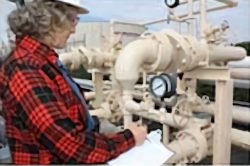Operating Procedures
Employer Requirements
The employer must develop and implement written operating procedures, consistent with the process safety information, that provide clear instructions for safely conducting activities involved in each covered process.

A "covered Process" is any process involving a highly hazardous chemical where the chemical is present in quantities at or above the specified threshold quantities listed in OSHA 1910.119 App A.
Operating procedures provide specific instructions on the steps to take in a covered process. The specific instructions should include safety precautions and information on safety implications.
For example, operating procedures that address parameters will include instructions about:
- pressure limits,
- temperature ranges,
- flow rates, what to do when an upset condition occurs, and
- what alarms and instruments are pertinent if an upset condition occurs.
Another example of using instructions to properly implement operating procedures would be for an equipment start-up process. Different parameters will be required from those of normal operation. In this example, operating instructions need to:
- clearly indicate the distinctions between startup and normal operations, such as the appropriate allowances for heating up a unit to reach the normal operating parameters.
- describe the proper method for increasing the temperature of the unit until the normal operating temperatures are reached.
Knowledge Check Choose the best answer for the question.
5-1. Which of the following Process Safety Management (PSM) program components provides specific instructions on the steps to take in a process?
You forgot to answer the question!
